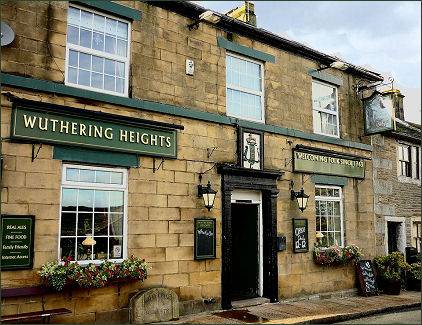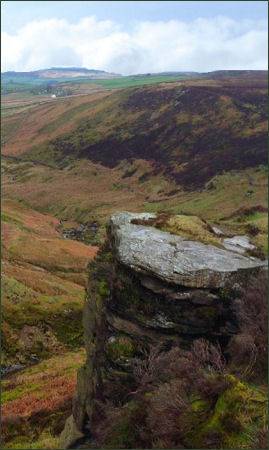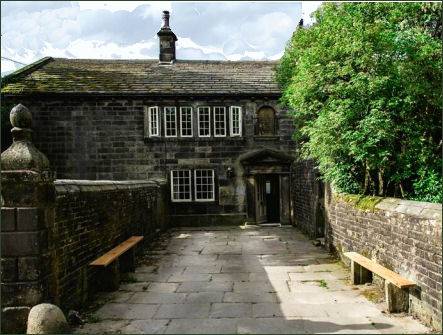Stanbury
OS grid reference:-

 Stanbury is situated in a superb setting on the River Worth and has many associations with the famous Bronte family. The village lies around a mile (1.6 km) to the west of Haworth and 4 miles (6.4 km) miles to the south-west of Keighley.
Stanbury is situated in a superb setting on the River Worth and has many associations with the famous Bronte family. The village lies around a mile (1.6 km) to the west of Haworth and 4 miles (6.4 km) miles to the south-west of Keighley.
Stanbury is a typical moorland village of the Pennines with gritstone cottages and farms.
The village has two public houses, the Wuthering Heights, (pictured left) formerly known as 'The Cross' and and The Friendly. The Old Silent Inn, a 400 year old country inn of much character, lies near to the village. The pub offers traditional locally sourced English food.
Stanbury was the home of Timmy Feather (1825-1910), who was the last of the Airedale handloom weavers and is featured in an exhibition at the Bronte Weaving Shed in Haworth.
Surrounded by a landscape of heather moorland, the village is close to the Bronte waterfall and Top Withens, an isolated, abandoned farm on Haworth Moor which is said to be the inspiration for the Earnshaw home in Emily Bronte's classic masterpiece 'Wuthering Heights', a tale of love and revenge on the Yorkshire moors.
The likely inspiration for Penistone Crags is Ponden Kirk (OS Grid reference- SE 981 364), an outcrag of gritstone rock (pictured right) about a kilometre to the north of Top Withens. It has a hole in the base large enough to crawl through which corresponds to the Fairy Cave in the book, where Hareton courted the Catherine Linton, Cathy's daughter. Emily Bronte regularly walked on the local moors and is believed to have used local features and places in her book.
The derivation of the name is shrouded in mystery, the word Kirk is a northern English and Scots term for a church. One opinion is that the crag could have possessed significance for a pre-Christian religion. Legend still clings to it, local folklore relates that if a girl crawls through the hole, she will marry within a year.
Ponden Hall
 Ponden Hall, which stands half a mile from the edge of Stanbury was reputedly the inspiration for Thrushcross Grange, the home of the Linton family, Edgar, Isabella, and Cathy, in Emily Brontė's novel 'Wuthering Heights'. It does not, however appear to match the description given in the novel for Thrushcross Grange and seems nearer in size and appearance
to the farmhouse of Wuthering Heights itself.
Ponden Hall, which stands half a mile from the edge of Stanbury was reputedly the inspiration for Thrushcross Grange, the home of the Linton family, Edgar, Isabella, and Cathy, in Emily Brontė's novel 'Wuthering Heights'. It does not, however appear to match the description given in the novel for Thrushcross Grange and seems nearer in size and appearance
to the farmhouse of Wuthering Heights itself.
The Bronte biographer Winifred Gerin believed that Ponden Hall was the original of Wildfell Hall, where Helen Graham, the protagonist of Anne Brontė's 'The Tenant of Wildfell Hall', fled from her husband. Ponden has similar architectural features to Wildfell, with latticed windows, a central portico and date plaque above.
The house was built in 1634 by Robert Heaton (1587-1641) for his son, Michael Heaton (1609-1643), although the east end incorporates an older building from 1541. The "old porch and peat house" was later built by Michael's son Robert (1642-1704) and in 1801 the hall was re-built by his great-grandson, Robert Heaton (1757-1817).
In the early ninteenth century Ponden Hall held what was reputedly the largest private library in Yorkshire, the Bronte children, who lived at nearby Haworth Parsonage were regullar visitors and often played with the Heaton children
There are two entwined and twisted pear trees in the garden, which are said to have been planted by one of the boys, Robert, who was particularly fond of Emily Bronte. The Heaton family were textile manufacturers in the nineteenth century. With the death of Robert Heaton in 1898, the Hall was sold.
In 2014 the house became a bed-and-breakfast establishment.
Towns and Villages of Yorkshire
